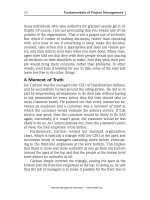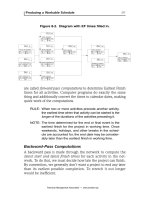Exploring management 6th by schermerhornch14
Bạn đang xem bản rút gọn của tài liệu. Xem và tải ngay bản đầy đủ của tài liệu tại đây (805.4 KB, 48 trang )
Exploring
Management
John R. Schermerhorn, Jr. and Daniel G. Bachrach
Sixth Edition
Chapter 14
Teams and Teamwork
“The way a team plays as
a whole determines its
success. You may have the
greatest bunch of
individual stars in the
world, but if they don’t
play together, the club
won’t be worth a dime.”
Former UCLA coach John
Wooden
Copyright ©2018 John Wiley & Sons, Inc.
2
Your Chapter 14 Takeaways
• Understand the importance of teams and
teamwork. (14.1)
• Identify the building blocks of successful
teamwork.(14.2)
• Understand how managers create and lead highperformance teams. (14.3)
Copyright ©2018 John Wiley & Sons, Inc.
3
TEAMS AND TEAMWORK 14.1
Takeaway 14.1 - answers to come
• Teams offer synergy and other benefits
• Teams can suffer from performance problems.
• Organizations are networks of formal teams and
informal groups.
• Organizations use committees, task forces, and
cross-functional teams.
• Virtual teams are increasingly common in
organizations.
• Self-managing teams are a form of job enrichment
for groups.
Copyright ©2018 John Wiley & Sons, Inc.
4
TEAMS AND TEAMWORK 14.1
Teamwork Benefits
• Team
• collection of people with complementary skills
who work together to accomplish shared goals
while holding each other mutually
accountable for performance results
• Teamwork
• The process of people actively working
together to accomplish common goals
• Synergy
• the creation of a whole that exceeds the sum
of its parts Copyright ©2018 John Wiley & Sons, Inc.
5
TEAMS AND TEAMWORK 14.1
Team Benefits
Why Teams Are Good for Organizations
More resources for problem solving
Improved creativity and innovation
Improved quality of decision making
Greater commitment to tasks
Increased motivation of members
Better control and work discipline
More individual need satisfaction
Copyright ©2018 John Wiley & Sons, Inc.
6
TEAMS AND TEAMWORK 14.1
Team Performance Problems
• Social loafing (or free-riding)
• The tendency of some people to avoid
responsibility by free-riding in groups
• How to handle social loafing
• Reward individuals for contributions
• Make individuals visible by keeping team size
small
• Encourage peer pressure to perform
• Make task assignments more interesting
Copyright ©2018 John Wiley & Sons, Inc.
7
TEAMS AND TEAMWORK 14.1
Formal and Informal Teams
Formal teams
• Officially recognized
and supported by the
organization
• Department
• Work units
• Teams
• Divisions
Informal groups
• Grow spontaneously
from co-worker
relationships
• Interest groups
• Friendship groups
• Support groups
Copyright ©2018 John Wiley & Sons, Inc.
8
TEAMS AND TEAMWORK 14.1
Roles Managers Play in Teams
Copyright ©2018 John Wiley & Sons, Inc.
9
TEAMS AND TEAMWORK 14.1
Types of Teams
Committee
Project Teams or
Task Forces
brings together people outside of their daily job
assignments to work in a small team for a specific
purpose; the task agenda is specific and ongoing
bring together people from various parts of the
organization to work on common problems
Cross-Functional
Team
Employee-Involvement
Team
has members from different functional units
Quality
Circle
is a group of workers that meets regularly to discuss and
plan specific ways to improve work quality
has members who meet on a regular basis to apply their
expertise to continuous improvement
Copyright ©2018 John Wiley & Sons, Inc.
10
TEAMS AND TEAMWORK 14.1
Virtual
Teams
Use technology to work together from different locations
Steps to Successful Virtual Teams
• Select team members with positive attitudes and who are capable
of self-starting.
• Select members high in initiative with proven records
• Begin with social messaging that allows members to exchange
information about one another to personalize the process.
• Assign clear goals and roles so members can focus while working
alone and also know what others are doing.
• Gather regular feedback from members about how they think the
team is doing and how it might do better.
• Provide regular feedback to team members about team
accomplishments.
• Make sure the team has the best virtual meeting technology.
Copyright ©2018 John Wiley & Sons, Inc.
11
TEAMS AND TEAMWORK 14.1
Self-Managing Teams
Members have collective authority to make
decisions about how they share and complete
work
FIGURE 14.1 What Are the Management Implications of
Self-Managing Teams?
Copyright ©2018 John Wiley & Sons, Inc.
12
TEAMS AND TEAMWORK 14.1
Study Guide for Takeaway 14.1
Rapid Review:
• A team consists of people with complementary skills working
together for shared goals and holding one another accountable for
performance.
• Teams benefit organizations by providing for synergy that allows the
accomplishment of tasks that are beyond individual capabilities
alone.
• Social loafing and other problems can limit the performance of
teams.
• Organizations use a variety of formal teams in the form of
committees, task forces, project teams, cross-functional teams, and
virtual teams.
• Self-managing teams allow team members to perform many tasks
previously done by supervisors.
Copyright ©2018 John Wiley & Sons, Inc.
13
TEAMS AND TEAMWORK 14.1
Study Guide for Takeaway 14.1
Questions for Discussion:
1. Do committees and task forces work better
when they are given short deadlines?
2. Are there some things that should be done only
by face-to-face teams, not virtual ones?
3. Why do people in teams often tolerate social
loafers?
Copyright ©2018 John Wiley & Sons, Inc.
14
TEAMS AND TEAMWORK 14.1
Be Sure You Can…for Takeaway 14.1
• define “team” and “teamwork.”
• describe the roles managers play in teams.
• explain synergy and the benefits of teams.
• discuss social loafing and other potential problems of
teams.
• differentiate formal and informal groups.
• explain how committees, task forces, and cross-functional
teams operate.
• describe potential problems faced by virtual teams.
• list the characteristics of self-managing teams.
Copyright ©2018 John Wiley & Sons, Inc.
15
SUCCESSFUL TEAMWORK 14.2
Takeaway 14.2 – answers to come
• Teams need the right members to be effective.
• Teams need the right setting and size to be effective.
• Teams need the right processes to be effective.
• Teams move through different stages of development.
• Team performance is affected by norms.
• Team performance is affected by cohesiveness.
• Team performance is affected by task and maintenance
activities.
• Team performance is affected by communication
networks.
Copyright ©2018 John Wiley & Sons, Inc.
16
SUCCESSFUL TEAMWORK 14.2
Effective Teams
• Effective teams have three output
goals:
• Task performance
• Member satisfaction
• Team viability
Copyright ©2018 John Wiley & Sons, Inc.
17
SUCCESSFUL TEAMWORK 14.2
Effective Teams
Figure 14.2 What Are the Foundations
of Team Effectiveness?
Copyright ©2018 John Wiley & Sons, Inc.
18
SUCCESSFUL TEAMWORK 14.2
Effective Teams
Teams need the right members for the tasks to be
accomplished.
• Team diversity
• the mix of skills, experiences, backgrounds, and
personalities of team members
• Homogeneous teams
• have members with similar personal characteristics
• Heterogeneous teams
• have members with diverse personal characteristics
Copyright ©2018 John Wiley & Sons, Inc.
19
SUCCESSFUL TEAMWORK 14.2
Effective Teams
Team Effectiveness =
Quality of Inputs + (Process Gains – Process Losses)
Input foundations for team effectiveness
• Membership composition – diversity of skills, experiences,
backgrounds, personalities
• Nature of task – clear and defined versus open-ended and
complex
• Organizational setting – information, resources, technology,
space
• Team size – smaller versus larger, odd/even count
Copyright ©2018 John Wiley & Sons, Inc.
20
SUCCESSFUL TEAMWORK 14.2
Effective Teams
• The organizational setting influences team outputs
• Team Size also makes a difference
• Ideal team size is 5-7 members for creative tasks
• Teams need the right processes to be effective.
• Team process
• the way team members work together to accomplish
tasks
• Team IQ
• the ability of a team to perform well by using talent
and emotional intelligence
Copyright ©2018 John Wiley & Sons, Inc.
21
SUCCESSFUL TEAMWORK 14.2
Team Development
Stages of team development
Forming
team development, one of initial task
orientation and interpersonal testing.
Storming
conflict over tasks and working as a team
Norming
coordination of task and operating
agendas
effective teamwork and focused task
performance.
completion of task, team may disband
Performing
Adjourning
Copyright ©2018 John Wiley & Sons, Inc.
22
SUCCESSFUL TEAMWORK 14.2
Team Development
Stages of team development
Copyright ©2018 John Wiley & Sons, Inc.
23
SUCCESSFUL TEAMWORK 14.2
Team Development Challenges
FIGURE 14.3 What Are the Criteria for Assessing the Process Maturity of a Team?
Copyright ©2018 John Wiley & Sons, Inc.
24
SUCCESSFUL TEAMWORK 14.2
Performance
• Performance is affected by norms and
cohesiveness
• Norms
• Expected behaviors
• Performance Norm
• Amount of effort expected by team members.
• Team virtuousness
• Indicates the extent to which members adopt
norms that encourage shared commitments to
moral behavior.
Copyright ©2018 John Wiley & Sons, Inc.
25









